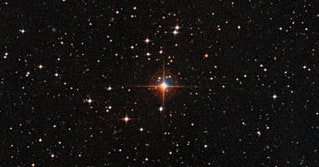Stephen Kane was searching for stars that could host planets with warm, temperate climates hospitable to life—you know, like Earth—when he glimpsed a young red dwarf called AU Microscopii that’s “only” 32 light-years away from home.
“The star’s a complete infant, when it comes to planetary systems. That means we have an opportunity here to observe a planet at the very earliest stages of the planet evolving,” he says. So Kane, an astrophysicist at the University of California at Riverside, and his colleagues used the star as a laboratory and as a model for others like it, projecting its future life. That helped them figure out when the planets orbiting it might fall within the star’s “habitable zone”—a distance that is neither too hot nor too cold to support life. They found that the star would blaze brightly at first, then calm down and burn less intensely, so that the range of life-friendly spots would move closer toward the star by about 30 to 40 percent during the star’s first 200 million years. They published their work this month in the The Astronomical Journal.
That’s significant for Kane and other scientists, who hope to one day catch sight of a life-friendly world beyond Earth, with verdant ecosystems teeming with alien life-forms, because it suggests that a planet in a habitable spot might not stay habitable forever. For the best-case “Goldilocks” scenario, everything has to be just right, including a temperature that allows the planet to have liquid water on the surface—a prerequisite for life as we know it. (Life as we don’t know it is another story.) Other factors matter, too, like a breathable atmosphere, a stable climate, and enough protection from harsh ultraviolet radiation. Mars, for example, is in our sun’s habitable zone, but it lost its water and most of its atmosphere eons ago. Venus lies on the inner edge of the zone, but thanks to its veil of carbon dioxide, it’s blistering hot.
AU Microscopii gives scientists a glimpse at how that zone might grow or shrink over a star’s lifetime. “These red dwarf stars have a very long, very badly behaved teenage phase. It can be hundreds of millions of years before a star like this finally settles down like an adult,” says Sara Seager, an MIT astrophysicist and former deputy science director of NASA’s planet-finding mission called TESS.
Kane and his team show that since their red dwarf and other stars like it can act like teenagers for a while, a currently inhospitable world might become more amenable to life down the road. But the reverse could happen too: “A planet that is in the habitable zone now may not still be there once the star is changing,” he says.
If the host star cools down quite a bit, the planet could become too frigid for any ET’s eking out a living on it; lakes and rivers would gradually freeze. On the other hand, much older stars usually eventually heat up, so aliens who were once in a life-friendly spot could eventually see the water necessary for life boil away, as anything on their planet’s surface gets baked to death.

































